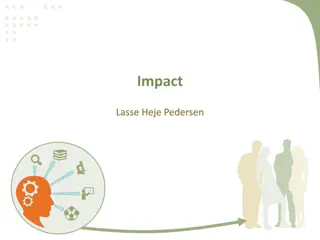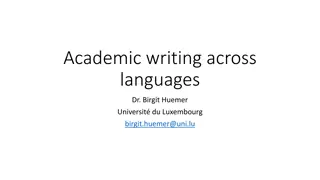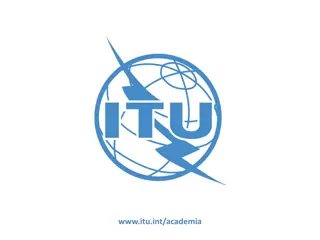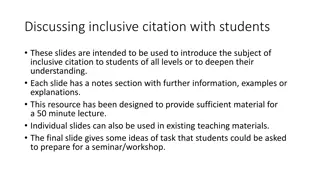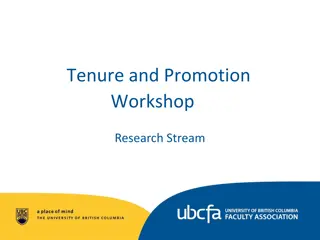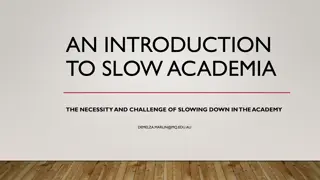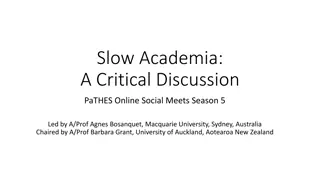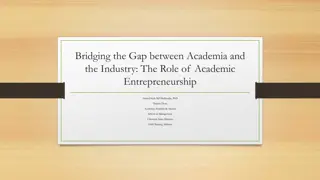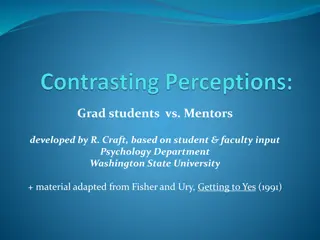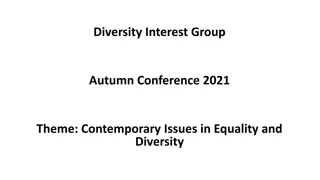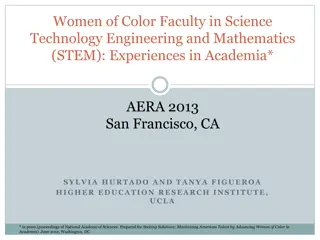Understanding Research Impact and Assessment in Academia
Research4Life focuses on scholarly communication, research assessment, and bibliometrics. It explores research impact evaluation, key factors for assessment, methodologies used, and the importance of balancing qualitative and quantitative approaches in academic assessment schemes.
Download Presentation

Please find below an Image/Link to download the presentation.
The content on the website is provided AS IS for your information and personal use only. It may not be sold, licensed, or shared on other websites without obtaining consent from the author. Download presentation by click this link. If you encounter any issues during the download, it is possible that the publisher has removed the file from their server.
E N D
Presentation Transcript
SCHOLARLY COMMUNICATION AND RESEARCH4LIFE Research Assessment And Bibliometrics Research4Life is a public-private partnership of five collections:
Lesson outline Research assessment and academic evaluation. Bibliometrics and indicators for research impact. Citation analysis and research performance Summary. v1.2 June 2021 This work is licensed under Creative Commons Attribution-ShareAlike 4.0 International (CC BY-SA 4.0)
Learning objectives Become familiar with research impact and how it is evaluated Understand commonly used indicators and methodologies Understand alternative merits to journal-based metrics Recognize existing tools such as Google scholar, altmetrics, Scopus, Web of science, dimension, scival, incites
Research Impact Research impact can simply be defined as the good that researchers can do in the world. Academic impact, the focus of this lesson, is the intellectual contribution that a researcher has made in his/her field of study within academia. Forms of research impact include: 2 1 3 4
Key factors for evaluating research impact in research orgs. Accountability to demonstrate to funders the value of their research investment and enhance the chances for further funding. Understanding to understand how research leads to impact, and thus ways in which it can be developed to maximize the impact of research findings. Performance evaluation research impact assessment is being used widely in guidelines for employment, performance evaluation and promotion of researchers.
Methodologies used to evaluate research impact There are two main approaches: Qualitative approach Quantitative approach Qualitative approach uses narratives such as peer review. Scholarly manuscripts are scrutinized by those in the same field, feedback and judgements are then used to improve the research. Quantitative approach is based on measurable indicators or metrics. Quantitative metrics are convenient, easy to understand and less time-consuming to produce.
Research impact assessment Overemphasis on metrics in academic research impact assessment brought adverse effects to both researchers and research organizations. Researchers and practitioners in scholarly communication have long called for better assessment schemes. The Declaration on Research Assessment (DORA) is one of those calls. It was developed in 2012. The main goal of DORA is to promote better research assessment by encouraging the development of and showcasing robust, efficient ways to evaluate research and researchers.
The Declaration on Research Assessment (DORA) Do not use journal-based metrics, such as Journal Impact Factors, as a surrogate measure of the quality of individual research articles, to assess an individual scientist s contributions, or in hiring, promotion, or funding decisions.
The Declaration on Research Assessment (DORA) cont. In response to the DORA general recommendation, the Leiden Manifesto for research metrics set out ten principles for a balanced and effective research evaluation scheme. In general, the golden rule for research impact assessment is to adopt both qualitative and quantitative approaches. Always use more than one metric/indicator when evaluating research.
The 10 principles for a balanced and effective research evaluation scheme 1. Quantitative evaluation should support qualitative, expert assessment 2. Measure performance against the research missions of the institution, group or researcher. 3. Protect excellence in locally relevant research. 4. Keep data collection and analytical processes open, transparent and simple. 5. Allow those evaluated to verify data and analysis 6. Account for variation by field in publication and citation practices. 7. Base assessment of individual researchers on a qualitative judgement of their portfolio. 8. Avoid misplaced concreteness and false precision. 9. Recognize the systemic effects of assessment and indicators. 10. Scrutinize indicators regularly and update them
Bibliometrics and indicators for research impact Bibliometrics are quantitative methods of analyzing research using publications as a proxy for research. Other metrics used in research assessments are: a) Scientometrics - covers output of science in general, not limited to publications b) Webmetrics (cybermetrics) covers indicators appearing on the WWW and other electronic resources c) Informetrics covers all information objects d) Alternative metrics (a.k.a. Altmetrics) covers page views/downloads, tweets, discussion, saves, recommends, and reports
Bibliometrics Aspects of the publication/bibliographic data that bibliometrics examine are: Characteristics of publication, i.e., the year, journal and document type, etc. Authorship, including collaboration among authors, organizations, countries, and funders) Research topics and subject categories Citation impact (cited references and citing articles)
Bibliometrics cont. Questions that bibliometrics can help to answer include: What is the productivity? (Using the number of articles by year/type/subject category/journal as the measurement) Who works together? Which organizations work together in certain research? Which countries work on certain research? Which organizations funded research/researchers together? What are the major research topics/areas and their trend? What is the citation impact? (Percent of articles in the top 10% of citations) Which guidelines and patents supported by certain research?
Bibliometric indicators Two bibliometric indicators are frequently used in research assessment tools: 1. The Journal Impact Factor (JIF) a journal-level bibliometric indicator. It is commonly used as a proxy for the relative importance of a journal. Example of JIF calculation
Bibliometric indicators cont. 2. The h-index - an individual-level bibliometric indicator used in evaluating research impact of a researcher by measuring both the productivity and citation impact of an author and of a journal. Example of h-index
Bibliometric indicators cont. 3. Altmetrics (alternative metrics) -attempts to indicate research impact based on the popularity of research output on the web including social media. *An example of attention for an article collected by Altmetric, a vendor that generates Altmetrics.
Prominent tools and services for research performance. Many data sources and tools are available to help conducting research impact analysis. They differ in terms of coverage, functionalities and analytical methods utilized. Users should choose the ones that best meet their needs.
Web of Science and Scopus These are online subscription-based scientific citation indexing services. Web of Science is maintained by Clarivate Analytics. Its 73 million records cover publications and citations back to 1900 from over 20,000 journals. Web of Science does not participate in Research4Life. Scopus, produced by Elsevier, contains 70 million records, with publication data from 1996 and citations back to 1970 from over 22,000 journals. Scopus is available to some Research4Life members.
InCites and SciVal InCites by Clarivate and SciVal by Elsevier offer advanced levels of metrics and analytical reports Useful for portfolio analysis and benchmarking of organizations and research programs InCites is built on Web of Sciences collections. SciVal is built on data from Scopus. Both tools are fee-based and do not participate in Research4Life
Dimensions Dimensions is a dynamic linked-research data platform. It allows users to explore the connections between publications, grants, clinical trials, patents and policy documents. The basic level of Dimensions is available to everyone, it offers full-text searching of publications data and some metrics. Dimensions Plus, an advanced level of access, is a fee-based product which covers additional content and offers additional analytical tools. Dimensions Plus is available to all Research4Life member organizations.
The Lens The Lens is an open facility for discovery, analysis, metrics and mapping of scholarly literature and patents. Since 2013, Lens.org has served the world most comprehensive public Patent Sequence platform to navigate biological patents from over 17 jurisdictions. It is comprised of three distinct databases Patent Records 129M records, Patents Sequence and Scholarly Works (228M records). As an open access search tool, The Lens databases are available to all Research4Life member organizations.
Google Scholar Citations It is a free tool available for everyone, it allows authors to keep track of citations to their articles. Authors can find out who is citing their publications, graph citations over time, and compute several citation metrics. Bibliometrics indicators, such as number of articles and h- index will be presented and updated automatically as new citations are added to Google Scholar. To see your own Google Scholar citations, visit https://scholar.google.com, sign in and click on My Citations .
Google Scholar Metrics 23 Help users to find a journal to publish. Accessible from the Google Scholar menu, provides metrics, e.g., h5-index for publications indexed in Google Scholar. For publications in English, the metrics can be filtered by subject category and sub-category.
Summary This lesson introduced the concept of research assessment, particularly in academia. Commonly used methodologies in research impact analysis, including bibliometric indicators were introduced. An overview of prominent existing tools and services for research assessment were shown towards the end of the lesson.
For more information on Research4Life www.research4life.org r4l@research4life.org Research4Life is a public-private partnership of five collections:



